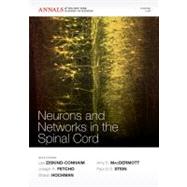
Note: Supplemental materials are not guaranteed with Rental or Used book purchases.
Purchase Benefits
What is included with this book?
Lea Ziskind-Conhaim is the editor of Neurons and Networks in the Spinal Cord, Volume 1198, published by Wiley. Joseph R. Fetcho is the editor of Neurons and Networks in the Spinal Cord, Volume 1198, published by Wiley.
2. Afferent inputs to mid- and lower-lumbar spinal segments are necessary for stepping in spinal cats (Jonathan A. Norton and Vivian K. Mushahwar).
3. Afferent control of locomotor CPG: insights from a simple neuromechanical model (Sergey N. Markin, Alexander N. Klishko, Natalia A. Shevtsova, Michel A. Lemay, Boris I. Prilutsky and Ilya A. Rybak).
4. Interactions between focused synaptic inputs and diffuse neuromodulation in the spinal cord (M.D. Johnson and C.J. Heckman).
5. Propriospinal transmission of the locomotor command signal in the neonatal rat (Kristine C. Cowley, Eugene Zaporozhets and Brian J. Schmidt).
6. Sensory-induced activation of pattern generators in the absence of supraspinal control (A. Lev-Tov, A. Etlin and D. Blivis).
7. Mechanisms of excitation of spinal networks by stimulation of the ventral roots (Michael J. O'Donovan, Agnes Bonnot, George Z. Mentis, Nikolai Chub, Avinash Pujala and Francisco J. Alvarez).
8. Synaptic integration of rhythmogenic neurons in the locomotor circuitry: the case of Hb9 interneurons (Lea Ziskind-Conhaim, George Z. Mentis, Eric P. Wiesner and David J. Titus).
9. Functional organization of V2a-related locomotor circuits in the rodent spinal cord (Kimberly J. Dougherty and Ole Kiehn).
10. Some principles of organization of spinal neurons underlying locomotion in zebrafish and their implications (Joseph R. Fetcho and David L. McLean).
11. Alternation of agonists and antagonists during turtle hindlimb motor rhythms (Paul S.G. Stein).
12. Multifunctional and specialized spinal interneurons for turtle limb movements (Ari Berkowitz).
13. Defining rhythmic locomotor burst patterns using a continuous wavelet transform (Benjamin W. Gallarda, Tatyana O. Sharpee, Samuel L. Pfaff and William A. Alaynick).
14. Presynaptic inhibition of primary afferents by depolarization: observations supporting nontraditional mechanisms (Shawn Hochman, Jacob Shreckengost, Hiroshi Kimura and Jorge Quevedo).
15. Synaptic pathways and inhibitory gates in the spinal cord dorsal horn (Tomonori Takazawa and Amy B. MacDermott).
16. Modulation of developing dorsal horn synapses by tissue injury (Mark L. Baccei).
17. Role of NKCC1 and KCC2 in the development of chronic neuropathic pain following spinal cord injury (Tera Hasbargen, Mostafa M. Ahmed, Gurwattan Miranpuri, Lin Li, Kristopher T. Kahle, Daniel Resnick and Dandan Sun).
18. Bone cancer pain (Juan Miguel Jimenez-Andrade, William G. Mantyh, Aaron P. Bloom, Alice S. Ferng, Christopher P. Geffre and Patrick W. Mantyh).
19. Timing and mechanism of a window of spontaneous activity in embryonic mouse hindbrain development (Martha M. Bosma).
20. Human stem cells as a model of motoneuron development and diseases (Yan Liu and Su-Chun Zhang).
21. Developmental regulation of subtype-specific motor neuron excitability (Rosa L. Moreno and Angeles B. Ribera).
22. Serotonin controls the maturation of the GABA phenotype in the ventral spinal cord via 5-HT1B receptors (Anne-Emilie Allain, Louis Ségu, Pierre Meyrand and Pascal Branchereau).
23. Mechanisms regulating the specificity and strength of muscle afferent inputs in the spinal cord (George Z. Mentis, Francisco J. Alvarez, Neil A. Shneider, Valerie C. Siembab and Michael J. O'Donovan).
24. Permanent reorganization of Ia afferent synapses on motoneurons after peripheral nerve injuries (Francisco J. Alvarez, Katie L. Bullinger, Haley E. Titus, Paul Nardelli and Timothy C. Cope).
25. Deconstructing locomotor networks with experimental injury to define their membership (Andrea Nistri, Giuliano Taccola, Miranda Mladinic, Gayane Margaryan and Anujaianthi Kuzhandaivel).
26. Spinal plasticity following intermittent hypoxia: implications for spinal injury (Erica A. Dale-Nagle, Michael S. Hoffman, Peter M. MacFarlane, Irawan Satriotomo, Mary Rachael Lovett-Barr, Stéphane Vinit and Gordon S. Mitchell).
27. Protecting motor networks during perinatal ischemia: the case for delta-opioid receptors (Stephen M. Johnson and Sara M.F. Turner).
28. Immune response by microglia in the spinal cord (Julie K. Olson).
29. How spinalized rats can walk: biomechanics, cortex, and hindlimb muscle scaling—implications for rehabilitation (Simon F. Giszter, Greg Hockensmith, Arun Ramakrishnan and Ubong Ime Udoekwere).
The New copy of this book will include any supplemental materials advertised. Please check the title of the book to determine if it should include any access cards, study guides, lab manuals, CDs, etc.
The Used, Rental and eBook copies of this book are not guaranteed to include any supplemental materials. Typically, only the book itself is included. This is true even if the title states it includes any access cards, study guides, lab manuals, CDs, etc.